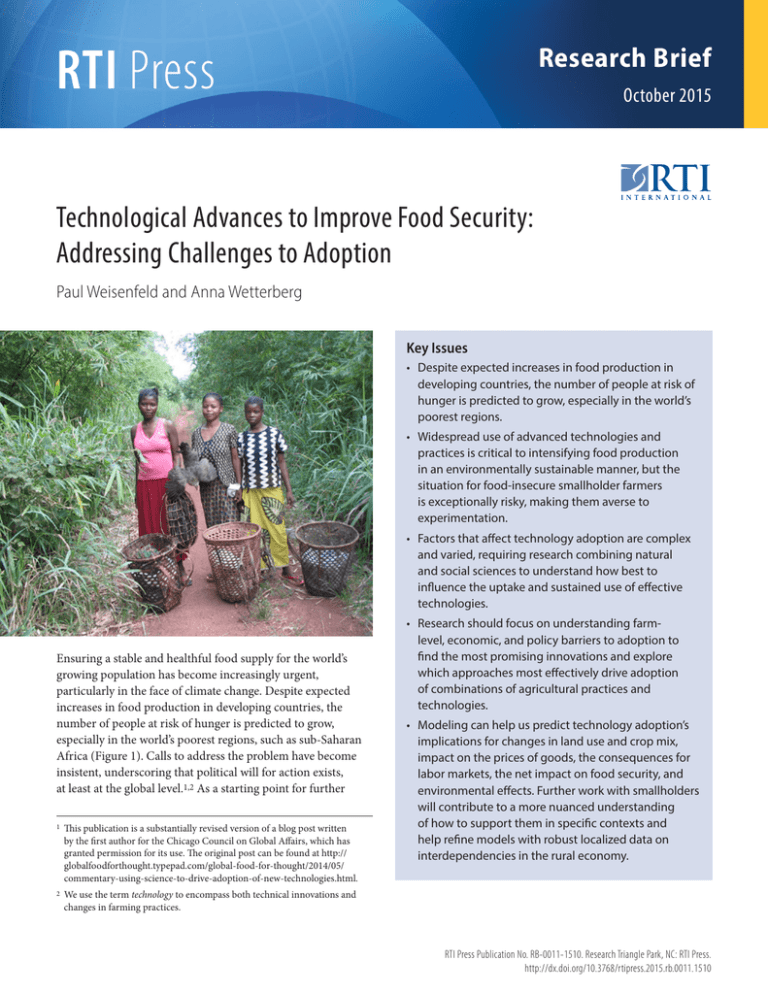
RTI Press
Research Brief
October 2015
Technological Advances to Improve Food Security:
Addressing Challenges to Adoption
Paul Weisenfeld and Anna Wetterberg
Key Issues
• Despite expected increases in food production in
developing countries, the number of people at risk of
hunger is predicted to grow, especially in the world’s
poorest regions.
• Widespread use of advanced technologies and
practices is critical to intensifying food production
in an environmentally sustainable manner, but the
situation for food-insecure smallholder farmers
is exceptionally risky, making them averse to
experimentation.
• Factors that affect technology adoption are complex
and varied, requiring research combining natural
and social sciences to understand how best to
influence the uptake and sustained use of effective
technologies.
Ensuring a stable and healthful food supply for the world’s
growing population has become increasingly urgent,
particularly in the face of climate change. Despite expected
increases in food production in developing countries, the
number of people at risk of hunger is predicted to grow,
especially in the world’s poorest regions, such as sub-Saharan
Africa (Figure 1). Calls to address the problem have become
insistent, underscoring that political will for action exists,
at least at the global level.1,2 As a starting point for further
1
This publication is a substantially revised version of a blog post written
by the first author for the Chicago Council on Global Affairs, which has
granted permission for its use. The original post can be found at http://
globalfoodforthought.typepad.com/global-food-for-thought/2014/05/
commentary-using-science-to-drive-adoption-of-new-technologies.html.
2
We use the term technology to encompass both technical innovations and
changes in farming practices.
• Research should focus on understanding farmlevel, economic, and policy barriers to adoption to
find the most promising innovations and explore
which approaches most effectively drive adoption
of combinations of agricultural practices and
technologies.
• Modeling can help us predict technology adoption’s
implications for changes in land use and crop mix,
impact on the prices of goods, the consequences for
labor markets, the net impact on food security, and
environmental effects. Further work with smallholders
will contribute to a more nuanced understanding
of how to support them in specific contexts and
help refine models with robust localized data on
interdependencies in the rural economy.
RTI Press Publication No. RB-0011-1510. Research Triangle Park, NC: RTI Press.
http://dx.doi.org/10.3768/rtipress.2015.rb.0011.1510
Technological Advances to Improve Food Security
research and discussion among policy makers, development
practitioners, and researchers, this brief points to some of
the complex factors related to adopting technologies that can
address these challenges.
Technical innovations and improved farming practices that
increase agricultural production and productivity while
enhancing climate resilience exist. These include droughttolerant seed varieties, drip irrigation, and the precision
application of fertilizers and agrochemicals, as well as
practices such as integrated pest management, conservation
farming, and improved watershed and soil management,
among others. However, getting these technologies into the
hands of the farmers who will benefit most from them is not
straightforward. Although technology is not a panacea, it is
key to addressing the food production side of the food security
equation. Increasing food production simply by using more—
land, water, seeds, fertilizer, and pesticides—will not achieve
the significant improvements in productivity necessary to
advance the economic well-being of the food insecure. Equally
important, the “more” approach is limited by the scarcity
of resources and contributes to greenhouse gas emissions,
deforestation and other environmental ills.2 Hence, widespread
use of advanced technologies and practices is critical to
intensifying production in an environmentally sustainable
manner.
Figure 1a. Predicted change in crop production between
2010 and 2050: selected regions
If technology and improved farming practices are clearly
valuable, why is it that poor smallholder farmers in food
insecure areas of sub-Saharan Africa, Central America, and
South Asia do not readily adopt them? Although farming, like
all productive endeavors, entails inherent risks, the situation
for food-insecure smallholder farmers is exceptionally risky,
making them averse to experimentation. In addition to farmlevel risks (Figure 2), rural populations who participate in
markets—for their crops, agricultural inputs, farm labor, and/
or for food to supplement their own production—expose
themselves to additional risks associated with fluctuating
prices. Miscalculations that would be absorbed by a wealthier
farmer can result in destitution or even starvation for a
subsistence farmer and her family.3 On a practical level, the
decision not to adopt a more advanced technology can be a
risk mitigation strategy itself. For instance, more advanced
hybrid seed varieties typically cost more and require the use of
costly fertilizer—a significant investment that can be lost if the
rains fail to come.4
The social, economic, and other factors that affect technology
adoption are complex and varied, requiring research that
combines natural and social sciences to understand how
best to influence the uptake and sustained use of effective
technologies. Research should focus on four areas where
complex combinations of challenges inhibit adoption.
Figure 1b. Predicted change in the number of people at
risk between 2010 and 2050: selected regions
200
60
180
50
160
40
120
Percent
Percent
140
100
80
60
20
40
20
0
30
10
Developing
countries
Maize
production
South
Asia
Rice
production
Sub-Saharan
Africa
Wheat
production
0
Developing
countries
South
Asia
Sub-Saharan
Africa
Source: Adapted from Chapter 5 in Rosegrant et al.18
Note: Predictions assume greenhouse gas emissions based on rapid economic growth, midcentury peak in global population growth, development of efficient technologies,
and balanced energy sources.
RTI Press: Research Brief2
RTI Press Publication No. RB-0011-1510. Research Triangle Park, NC: RTI Press.
http://dx.doi.org/10.3768/rtipress.2015.rb.0011.1510
Technological Advances to Improve Food Security
Understanding (1) farm-level, (2) economic, and (3) policy
barriers can illuminate where promising innovations may be
viable. Further, researchers should explore which approaches
most effectively drive adoption of (4) combinations of
agricultural practices and technologies, rather than individual
innovations in isolation.
and inputs (e.g., labor, education, information, credit) that
influence their technology choices. For instance, although
Ghanaian cocoa farmers increased fertilizer use ninefold
overall between 2002 and 2004, 42% of male farmers but only
25% of female farmers reported using fertilizer.6
Further, the characteristics of particular farms—such as
water access, tenure arrangements, and plot size—can affect
whether farmers switch technologies. Analyzing these
characteristics is complicated because they may vary across
an individual farmer’s holdings and therefore not align well
with households or farms as units of analysis.7 For example,
land tenure security has been shown to increase adoption of
sustainable technologies,8,9 because farmers expect to reap
benefits from investments on owned land. Farmers who
lack clear ownership—often women—must include loss of
access to a plot as a risk when weighing investments in new
technologies.10 A single farmer may have different types
of ownership arrangements for individual plots, leading to
incomplete adoption of more productive technologies, even by
receptive farmers.
Farm-Level Barriers
The high risks of switching technologies generally make
farmers reluctant to shift away from established agricultural
methods—such as traditional/saved seeds, traditional tillage,
reliance on family labor, animal manure for fertilizer, and
long-subsidized inputs—to test new practices and inputs. At
the farm level, they may also face a range of specific constraints
related to access to, use of, and awareness or availability of
technological choices. Although studies exist that identify such
constraints, more research is needed to inform programmatic
approaches to facilitate adoption.
Research has shown that some types of farmers are especially
unlikely to adopt new technologies. In addition to overall
wealth and access to resources (such as household labor and
nonfarm income), the age, gender, and education of a farmer
can influence adoption.4,5 In particular, women farmers often
face constrained access to assets (e.g., land rights, bicycles)
Variation in adoption patterns has also been linked to
differences in how information is effectively communicated
and in the types of information that individual farmers can
access. In general, improving access to education will facilitate
Risks torisks
Agriculture
and Farmer Livelihood
Security Risks
Figure 2. Farm-level
facing smallholders,
with reported averages for Madagascar, Food
in percentage
of farmers affected
(& farmers affected)
(& farmers affected)
81%
Severe Pest Damage
Severe Drought
Extreme
Weather
Disease
Outbreak
Severe
Flooding
75%
Farm output
does not feed
household
year-round
68%
51%
40%
47%
Household
suffers
distinct “lean
season” with
insufficient
food
44%
Post-harvest
Loss
36%
Source: Adapted by authors from Harvey et al.3
RTI Press: Research Brief
3
RTI Press Publication No. RB-0011-1510. Research Triangle Park, NC: RTI Press.
http://dx.doi.org/10.3768/rtipress.2015.rb.0011.1510
Technological Advances to Improve Food Security
technology adoption,5 but individual innovations may require
more tailored approaches that account for farmer, farm, and
technology features, as well as effective information channels.
System technologies are often knowledge intensive and require
local adaptation and experimentation to identify synergies
between components.7 Not surprisingly, research has shown
that the quality of extension services matters greatly for
facilitating adoption.8 Flexible services that consider locationspecific needs and priorities for improvement can help farmers
reduce the risk associated with the experimentation needed
for successful adoption.7 Decentralized extension services
that encourage local innovation may be best suited for some
technologies, and centralized modes of extension more
appropriate for others.11
Information gained through social networks is especially
important for recent adopters of new technologies. However,
segmented social structures and cultural barriers (religion,
ethnicity, gender) can impede social learning and information
sharing.12 Extension services and social learning are often
complementary, underscoring the need to take farmers’
social networks into account to maximize the effectiveness of
extension services.13
RTI Press: Research Brief4
Economic or Market Barriers
An effective technology that is readily adopted in one setting
may not be economically viable in another, even within
similar agronomic zones. Research to identify market barriers
to adoption must consider the full value chain, taking
into account costs, market readiness, supply chains, and
distribution partners.14,15 Overlooking parts of the value chain
when assessing feasibility can severely undermine the uptake
of new technologies. For example, Abebe et al.16 found that low
adoption rates of high-yielding, disease-tolerant potato strains
in Ethiopia were partly explained by consumers’ preference
for the taste of traditional varieties, highlighting the economic
ramifications of social and cultural factors.
Commodity prices at local and national levels, as well as global
trade flows, are predicted to shift with climate change, affecting
the profitability of both existing and new technologies.17
In addition to value chain research, modeling can help us
understand patterns of climate variability and food security,
as well as related market dynamics that can drive or inhibit
adoption of specific technologies in particular regions.18,19
RTI Press Publication No. RB-0011-1510. Research Triangle Park, NC: RTI Press.
http://dx.doi.org/10.3768/rtipress.2015.rb.0011.1510
Technological Advances to Improve Food Security
Further, some technologies that have been shown to enhance
sustainable agricultural intensification—for example, improved
watershed management—have greater public than private
benefits. Adoption of such technologies faces significant
economic barriers, because farmers often do not reap visible,
short-term gain from investments in them. For example,
Rosegrant and his collaborators’ models demonstrate that
investing in drip and sprinkler irrigation produces small yield
increases where those technologies are adopted but results
in substantial water savings that can be applied elsewhere.18
Research could suggest mechanisms to address such
externalities and identify particular public investments that
facilitate adoption of other promising technologies, such as
improved watershed and soil management.
These constraints may be limited to specific locales, levels of
government, or industries. For example, in Tanzania, 61% of
subsidy vouchers are appropriated by village committees and
elected officials.21 In Ghana, the stable policy arrangement
between the cocoa industry and the government—referred to as
the “cocoa equilibrium”—particularly constrains prices paid to
smallholders.9
Other political factors affect entire countries’ prospects for
adopting new technologies. In Ethiopia, the state controls
the agricultural sector22 and in Greece, “piecemeal policy
frameworks and institutional rigidities” constrain technological
change.13 The Malawian government’s political imperative
to ensure food security has prompted seed and fertilizer
subsidies and other government actions that exacerbate price
instability.23 Although strong policy frameworks and supportive
government programs can facilitate broad adoption of
innovations, fragmented or entrenched policies and programs
skew technology choices and may distort market incentives for
particular production systems as climate variability increases.
Policy Barriers
Policy can also inhibit adoption of new technology, both by
driving up costs and/or by putting certain innovations out of
reach. Adoption of proven new technologies may be stymied
by policies such as subsidized inputs for existing technologies
or mono- or oligopolies on inputs and outputs that constrain
opportunities for change.20 Weak protections for intellectual
property and biotechnology policies can also hamper
technological innovation and change. Elites benefiting from
the existing agricultural system and institutional arrangements
(including explicit and implicit subsidies) often resist
technological shifts.
Feasible Combinations of Technologies
Although research has demonstrated that individual
technologies can increase productivity in the face of climate
variability,16 farmers must consider innovations within the
context of other practices. Further, effective technologies
often involve combinations of innovations (e.g., improved
fertilizer and hybrid seed4) or a set of practices (e.g., sustainable
intensification7,8) that can be overwhelming to introduce at one
time. More attention is therefore needed to identify effective
combinations of technologies that are feasible for farm-level
adoption in particular agro-economic zones. Such research
should explore both how technologies interact and how they
may be packaged or combined over time to facilitate adoption.
Such a focus will help us understand how innovations fit with
current technologies and identify complementarities and
substitutabilities between particular combinations of new and
existing approaches. For example, integrated natural resource
management and sustainable intensification practices have
been demonstrated to increase food production and facilitate
adaptation to climate change in several vulnerable zones.8,24
Modeling by Rosegrant et al.18 shows that combinations of
traditional technologies with heat- and drought-resistant
modern crop varieties can improve yields of corn, wheat, and
rice. However, several studies have shown low adoption rates of
integrated technologies,7,8 in part because they are not readily
affordable to smallholder farmers.24 Longitudinal research is
needed to trace patterns of adoption and rejection of combined
technologies over time and to design schemes to facilitate
technological shifts.5,25
RTI Press: Research Brief
5
RTI Press Publication No. RB-0011-1510. Research Triangle Park, NC: RTI Press.
http://dx.doi.org/10.3768/rtipress.2015.rb.0011.1510
Technological Advances to Improve Food Security
Conclusion
Although there is an existing body of research on the impact of
specific, individual factors constraining technology adoption
by farmers, understanding the full complexity of the situation
is needed if we are to design programs that measurably
increase the adoption of technologies and, more importantly,
combinations of technologies that can sustainably increase
production. Sophisticated modeling can map barriers at the
farm, market, and policy levels and illustrate how they interact
in different sociocultural and agro-ecological zones. Modeling
at both macro and micro levels can help us understand better
and predict the implications of technology adoption in terms
of changes in land use and crop mix, impact on the prices of
goods, the consequences on labor markets, the net impact
on food security, and the effect on the environment. Such
modeling may be particularly beneficial in understanding
the adoption of technologies that contribute to public goods,
such as improved watershed management or other climate
mitigation impacts.
4. Chirwa EW. Adoption of fertiliser and hybrid seeds by
smallholder maize farmers in Southern Malawi. Dev
South Africa. 2005;22(1):1-12.
5. Marenya PP, Barrett CB. Household-level determinants
of adoption of improved natural resources management
practices among smallholder farmers in western Kenya.
Food Policy. 2007;32(4):515-36.
6. Hill RV, Vigneri M. Mainstreaming gender sensitivity
in cash crop market supply chains. In: Quisumbing AR,
Meinzen-Dick R, Raney TL, Croppenstedt A, Behrman
JA, Peterman A, eds. Gender in agriculture. Amsterdam,
Netherlands: Springer; 2014. p. 315-41.
7. Noltze M, Schwarze S, Qaim M. Understanding
the adoption of system technologies in smallholder
agriculture: the system of rice intensification (SRI) in
Timor Leste. Agri Syst. 2012;108:64-73.
8. Kassie M, Teklewold H, Jaleta M, Marenya P, Erenstein O.
Understanding the adoption of a portfolio of sustainable
intensification practices in eastern and southern Africa.
Land Use Policy. 2015;42:400-11.
To complement models, we also need further work with
smallholders to understand how to facilitate technology
adoption and gather evidence on the agronomic, social, and
economic barriers farmers face. Such efforts will not only
contribute to a more nuanced understanding of how to support
smallholders in specific contexts, but also help to refine models
with robust localized data on interdependencies in the rural
economy.
9. Throup DW, Jackson C, Bain K, Ort R. Developing
commercial agriculture in Ghana. In: Fritz V, Levy B, Ort
R, eds. Problem-driven political economy analysis: the
World Bank’s experience. Washington, DC: World Bank;
2014. p. 145-74.
We should bring together natural and social science research
to find combinations of technologies, market factors, and
social and political forces that balance the needs of farmers
and society at large. Science is creating the tools to solve food
security challenges, but too many of them are locked in the
barn. We need to use the full range of science at our disposal to
ensure that these tools also get used in the fields.
11. Pamuk H, Bulte E, Adekunle AA. Do decentralized
innovation systems promote agricultural technology
adoption? Experimental evidence from Africa. Food
Policy. 2014;44:227-36.
References
1. Fan S. Food policy in 2014–2015: strong advances and
stubborn setbacks. In: Fan S, ed. 2014−2015 global food
policy report. Washington, DC: International Food Policy
Research Institute; 2015. p. 1-12.
2. Berry EM, Dernini S, Burlingame B, Meybeck A, Conforti
P. Food security and sustainability: can one exist without
the other? Public Health Nutr. 2015:1-10.
3. Harvey CA, Rakotobe ZL, Rao NS, Dave R,
Razafimahatratra H, Rabarijohn RH, et al. Extreme
vulnerability of smallholder farmers to agricultural risks
and climate change in Madagascar. Philos Trans R Soc
Lond B Biol Sci. 2014;369(1639):20130089.
RTI Press: Research Brief6
10. Goldstein M, Udry C. The profits of power: land rights
and agricultural investment in Ghana. J Polit Econ.
2008;116(6): 981-1022.
12. Conley TG, Udry CR. Learning about a new technology:
pineapple in Ghana. Am Econ Rev. 2010;100(1):35-69.
13. Genius M, Koundouri P, Nauges C, Tzouvelekas V.
Information transmission in irrigation technology
adoption and diffusion: social learning, extension services,
and spatial effects. Am J Agri Econ. 2014;96(1):328-44.
14. Guinn A, Hamrick D, Ahmed G, Abdulsamad A, Goger A,
Daly J, et al. Global value chain analysis and food security.
Durham, NC: Duke University; 2014 April.
15. Markelova H, Mwangi E. Collective action for smallholder
market access: evidence and implications for Africa. Rev
Policy Res. 2010;27(5):621-40.
RTI Press Publication No. RB-0011-1510. Research Triangle Park, NC: RTI Press.
http://dx.doi.org/10.3768/rtipress.2015.rb.0011.1510
Technological Advances to Improve Food Security
16. Abebe GK, Bijman J, Pascucci S, Omta O. Adoption
of improved potato varieties in Ethiopia: the role of
agricultural knowledge and innovation system and
smallholder farmers’ quality assessment. Agri Syst.
2013;122:22-32.
21. Pan L, Christiaensen L. Who is vouching for the input
voucher? Decentralized targeting and elite capture in
Tanzania. World Dev. 2012;40(8):1619-33.
22. Spielman DJ, Byerlee D, Alemu D, Kelemework D. Policies
to promote cereal intensification in Ethiopia: the search
for appropriate public and private roles. Food Policy.
2010;35(3): 185-94.
17. Zhang Y, Cai Y, Beach RH, McCarl BA. Modeling
climate change impacts on the US agricultural exports.
J Integrative Agri. 2014;13(4):666-76.
23. Ellis F, Manda E. Seasonal food crises and policy
responses: a narrative account of three food security crises
in Malawi. World Dev. 2012;40(7):1407-17.
18. Rosegrant MW, Koo J, Cenacchi N, Ringler C, Robertson
RD, Fisher M, et al. Food security in a world of natural
resource scarcity: the role of agricultural technologies.
Washington, DC: International Food Policy Research
Institute; 2014.
24. Akinnifesi FK, Ajayi O, Sileshi G, Chirwa PW, Chianu J.
Fertiliser trees for sustainable food security in the maizebased production systems of East and Southern Africa.
In: Lichtfouse E, Hamelin M, Navarrete M, Debaeke P, eds.
Sustainable agriculture, vol 2. Amsterdam, Netherlands:
Springer; 2011. p. 129-46.
19. Rosen S, Meade B, Fuglie K, Rada N. International food
security assessment, 2014−2024. Washington, DC: US
Department of Agriculture; 2014 June.
20. Benson T, Cunguara B, Mogues T. The supply of inorganic
fertilizers to smallholder farmers in Mozambique:
evidence for fertilizer policy development. Washington,
DC: International Food Policy Research Institute; 2012.
RTI Press: Research Brief
25. Vidogbéna F, Adégbidi A, Tossou R, Assogba-Komlan F,
Ngouajio M, Martin T, et al. Control of vegetable pests in
Benin—farmers’ preferences for eco-friendly nets as an
alternative to insecticides. J Environ Manage. 2015;147:
95-107.
7
RTI Press Publication No. RB-0011-1510. Research Triangle Park, NC: RTI Press.
http://dx.doi.org/10.3768/rtipress.2015.rb.0011.1510
Technological Advances to Improve Food Security
About the Authors
Paul Weisenfeld, JD, is executive vice president of RTI’s International
Development Group.
Anna Wetterberg, PhD, works as a social science research analyst in RTI’s
International Development Group.
RTI Press Research Briefs and Policy Briefs are scholarly essays on policy,
methods, or other topics relevant to RTI areas of research or technical focus.
RTI International, 3040 East Cornwallis Road, PO Box 12194
Research Triangle Park, NC 27709-2194 USA
+1.919.541.6000
rtipress@rti.org www.rti.org
©2015 Research Triangle Institute. All rights reserved. This document is
protected by copyright. Credit must be provided to the author and source of
the document when the content is quoted. No part of this document may be
reproduced without permission in writing from the publisher. RTI International
is a registered trademark and a trade name of Research Triangle Institute.
RTI Press publication RB-0011-1510
RTI Press: Research Brief8
www.rti.org/rtipress
RTI Press Publication No. RB-0011-1510. Research Triangle Park, NC: RTI Press.
http://dx.doi.org/10.3768/rtipress.2015.rb.0011.1510





